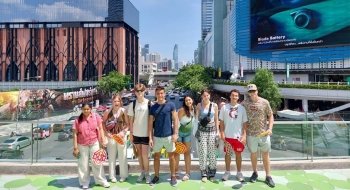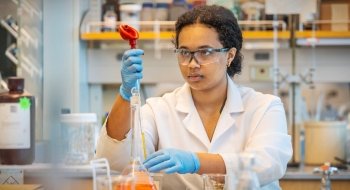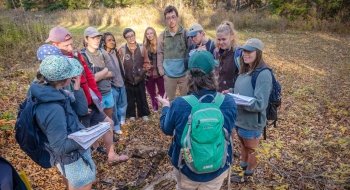
Neuroscience Research Fellow Discovers the Power of Perseverance
Nadiana Acevedo ’24 isn’t afraid of a challenge. When she set out to investigate the effects of an anti-cancer drug this summer, she discovered that sometimes the best learning experiences can come from trial and error.
As part of the Collegiate Science and Technology Entry Program (CSTEP), Nadiana spent eight weeks conducting research alongside Professor of Biology and Psychology Ana Estevez. The scholar program is designed to increase the number of historically underrepresented and economically disadvantaged students in mathematics, science, technology, and health-related fields.
Nadiana shared what fueled her curiosity for research and how she defines success.
(Note: Responses have been edited for length.)
Nadiana Acevedo ’24
Major: Neuroscience
Hometown: Buffalo, New York
Project Title: "Observing Cell Viability of HT-22 Hippocampal Cells When Exposed to Anti-Cancer Dye MKT-077"
How would you describe your research to someone who doesn’t know anything about the topic?
The focus of my research is looking at an anti-cancer dye, MKT-077. This dye is known to be selective to cancer cells meaning it only kills cancer cells. I am testing the drug on a mouse hippocampal neuronal cell line called HT-22 (brain cells) to observe the drug's effect on the cells' viability.
What about this topic sparked your curiosity?
Cancer research is challenging and exciting because it is full of trial and error. I was interested in looking at how this drug would affect neuronal cells because there is a lack of data specific to neurons. I was intrigued that MKT-077 is selective to cancer cells because other drugs kill both healthy and cancerous cells.
Was there a moment when you felt particularly challenged during your research process? How did you overcome it?
The research process was difficult at times because my mentor and I did not know how the MKT-077 would affect the HT-22 cells. The data seemed off in the beginning. We weren't sure if there was an issue with fluorescence when the microplate reader was collecting data. We had to run a test to determine if the MKT-077 had its own fluorescence that would interfere with the dye we used to measure viability. The data showed no conflict between the MKT-077 and the CYQUANT dye we used to measure cell viability.
What about your research are you the most proud?
I did not get discouraged by the research outcomes and was able to complete my summer research and presented my findings.
What's the most rewarding aspect of working closely with a faculty member?
Dr. Ana Estevez is an amazing advisor and mentor. I built a connection with her over the summer and learned many skills. She has helped me become a well-rounded researcher.
Finish this sentence: “Through my research, I hope to show others that…”
It is possible to succeed and gain knowledge regardless of the data outcome. There is always something to gain from every experience and there is always something new to discover.



